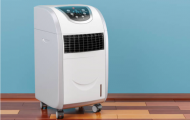Spring is a wonderful time. The air seems fresher, the landscape is bursting with color, and the grass is lush and green. For those with seasonal allergies, spring is a time to dread. More flowers mean more pollen. And that means troublesome hay fever, nasal congestion, and a general feeling of malaise.
Do you have seasonal allergies? Find out by checking this informative infographic from Disturb Me Not. The team at the site did a great job of explaining the difference between seasonal and perennial allergies, so we won’t go through them again.
Instead, in this post, we’ll look at tips for managing seasonal allergies.
Stay Inside When Pollen Levels Are High
This typically means staying indoors when the weather is windy and dry. Where possible, head out when it’s rainy, or just after the rain. The water helps particles in the air to settle. That, in turn, means that there are fewer particles flying around.
Avoid Gardening
“My allergies are acting up” is a valid reason to stay out of the garden. Where possible, get your family to mow the lawn and perform general garden maintenance. If you can’t resist, try and go out after a nice rainstorm.
Give Yourself a Silkwood Shower
Or a quick rinse. When you get home, change out of the clothes that you wore quickly. Then take a shower to get rid of pollen that’s in your hair or on your skin.
Use the Drier
It’s not the most environmentally-friendly appliance, but a drier can save you a lot of grief. When you hang your laundry outside, the wind can deposit small bits of pollen onto it. Use the drier to prevent this from happening.
Consider Wearing a Mask Outside
It’s not the sexiest look, granted, but it does stop you breathing in pollen. If you have severe seasonal allergies, this is a step that you’ll want to consider seriously.
Check the Pollen Counts
Do look out for pollen forecasts. You’ll find these on weather channels, on the radio, online, or in the newspaper. If the counts are high or expected to rise, take allergy meds proactively. This can prevent a flare-up later.
If the counts are high, it’s time to crank up the aircon and close the windows and doors. This helps to keep pollen out of your home. Pollen levels are usually lowest in the morning, so try and get outdoor chores accomplished early in the day.
Tips to Manage Indoors
- When driving to and from work, close the windows and use the air conditioner instead.
- At home, use a high-performance filter to trap pollen before it gets inside. It’s important to maintain the filter as directed to ensure its optimal performance. If you can’t afford a system for the whole house, at least use one in your bedroom.
- It’s also a good idea to get a dehumidifier. This keeps the air in the home dry, and that helps to settle particles that might be in the air.
- When buying pillows and bedding, make sure that they’re hypoallergenic. Dust mites can worsen symptoms. Be sure to vacuum your bed and carpets regularly to reduce particulates.
- Find yourself a good quality HEPA vacuum cleaner to trap the particulates.
Final Notes
Hay fever can make your life a misery. Some of the tips listed above might seem extreme, but they can reduce exposure significantly. This, by itself, can prevent flare-ups and help to reduce the severity of symptoms.

